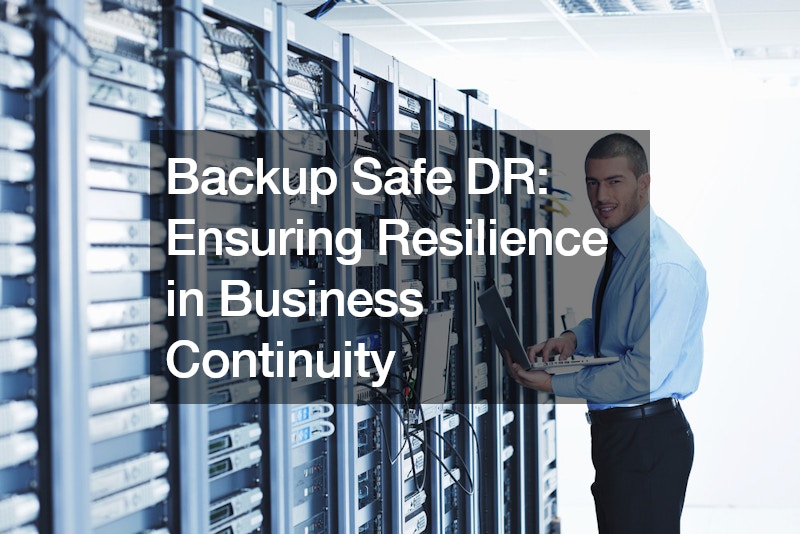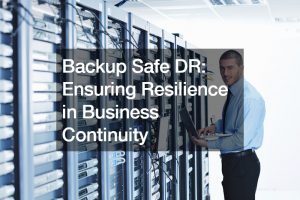In today’s digital landscape, ensuring business continuity is paramount. Businesses face a myriad of risks, from hardware failures to malicious cyber-attacks and natural disasters. To safeguard operations, it’s essential to understand the distinct roles of backup and disaster recovery (DR) and implement a robust strategy that encompasses both. This approach, termed ” backup safe DR” ensures that businesses remain resilient and can quickly bounce back from disruptions.
Understanding Backup and Disaster Recovery Backup and Disaster Recovery are often used interchangeably, but they serve different purposes. Both aim to protect your data and ensure continuity, but they address different types of failures and require different strategies.
Backup: Guarding Against Small-Scale Failures A backup is a copy of data taken at a specific point in time. It is designed to protect against small-scale failures such as hardware malfunctions or localized data corruption. Here’s how backups serve a critical role in maintaining business continuity:
Data Preservation: Regular backups ensure that data can be restored to a previous state in case of accidental deletion, corruption, or hardware failure. This minimizes data loss and ensures business operations can continue with minimal disruption. Protection Against Cyber Attacks: In an era where ransomware attacks are prevalent, reliable backup is crucial. If an attacker encrypts your data and demands a ransom, a robust backup strategy allows you to restore your systems without paying the ransom, thereby ensuring business continuity. Point-in-Time Recovery: Backups capture data at regular intervals, allowing businesses to restore data to a specific point in time. This is particularly useful for recovering from data corruption or accidental deletions. However, backups are generally manual processes and can take time to restore, making them less ideal for situations requiring immediate recovery.
Disaster Recovery: Safeguarding Against Large-Scale Failures Disaster Recovery (DR) focuses on restoring critical business functions after a catastrophic event such as natural disasters, significant hardware failures, or large-scale cyber-attacks. Here’s how DR ensures resilience:
Protection Against Regional Failures: Unlike backups, which handle localized issues, DR plans are designed to address region-wide failures. This includes hurricanes, earthquakes, or widespread power outages that can destroy entire data centers. High Availability and Minimal Downtime: DR strategies involve setting up a secondary site that mirrors the primary site’s operations. Data is continuously streamed from the primary to the DR site, ensuring minimal data loss. In a disaster, operations can quickly fail to the DR site, ensuring high availability and minimal downtime. Automated Failover: A robust DR strategy includes automated failover processes that minimize manual intervention. This ensures that systems can switch to the DR site quickly and efficiently, reducing the downtime and impact on business operations. Implementing a Backup Safe DR Strategy To achieve optimal resilience, businesses need a “backup safe DR” strategy that integrates both backup and DR. Here are the key components of such a strategy:
1. Regular Backups: Establish a schedule for regular backups, ensuring that all critical data is captured. This should include:
Incremental Backups: These backups capture only the changes made since the last backup, reducing storage requirements and speeding up the process. Full Backups: Perform full backups periodically to ensure a complete copy of all data is available. 2. Offsite and Cloud Backups: To protect against localized disasters, store backups in multiple locations, including offsite facilities and cloud storage. This ensures data can be recovered even if the primary site is compromised.
3. Continuous Data Replication Implement continuous data replication to the DR site. This ensures that data is always up-to-date and ready for failover in a disaster. Technologies such as real-time streaming and asynchronous replication can achieve this.
4. Automated Failover and Testing: Set up automated failover processes to ensure quick recovery during a disaster. Regularly test these failover procedures to identify and rectify any issues. This helps ensure that the DR plan will work as expected during an actual disaster.
5. Regular Audits and Updates Conduct regular audits of your backup and DR plans to ensure they remain effective and up-to-date. As business operations and technologies evolve, plans must be updated to address new challenges and requirements.
6. Employee Training and Awareness: Ensure employees are trained on the backup and DR procedures. Regular drills and training sessions can help familiarize staff with the processes and prepare them to act swiftly in a disaster.
Conclusion In an increasingly digital and interconnected world, a robust “backup safe DR” strategy is essential for business continuity. By understanding the distinct roles of backup and disaster recovery and integrating both into a comprehensive plan, businesses can safeguard their operations against various threats. Regular backups, continuous data replication, automated failover, and employee training are key components of this strategy, ensuring businesses remain resilient and quickly recover from any disruption.
.







